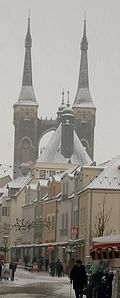- Köthen (Anhalt)
-
Köthen (Anhalt) Town hall 
Coordinates 51°45′0″N 11°55′0″E / 51.75°N 11.916667°ECoordinates: 51°45′0″N 11°55′0″E / 51.75°N 11.916667°E Administration Country Germany State Saxony-Anhalt District Anhalt-Bitterfeld Mayor Kurt-Jürgen Zander (SPD) Basic statistics Area 78.42 km2 (30.28 sq mi) Elevation 80 m (262 ft) Population 28,243 (31 December 2010)[1] - Density 360 /km2 (933 /sq mi) Other information Time zone CET/CEST (UTC+1/+2) Licence plate ABI Postal code 06366 Area code 03496 Website www.koethen-anhalt.de Köthen (Anhalt) ([ˈkøːtən] (
 listen)) is a city in Germany. It is the capital of the district of Anhalt-Bitterfeld in Saxony-Anhalt, about 30 km (19 mi) north of Halle.
listen)) is a city in Germany. It is the capital of the district of Anhalt-Bitterfeld in Saxony-Anhalt, about 30 km (19 mi) north of Halle.Köthen is the location of the main campus and the administrative center of the regional technical university Hochschule Anhalt which is especially strong in information technology. The city is conveniently located at the hub of the Magdeburg-Leipzig, Dessau–Köthen and Köthen–Aschersleben railways.
Köthen is situated in a fertile area with rich black soil suitable to the cultivation of sugar-beets. Industry includes high-tech engineering, manufacture of cranes, as well as chemicals, printing, and foodstuffs.
History
Owing to the fertile soil of the region, the area of Köthen is unusually rich in archaeological discoveries. The earliest signs of human habitation go back to the early Stone Age about 250,000 years ago, and evidence of every succeeding historical period may be found in the collections of the local Prehistorical Museum.
The first documentary mention of "Cothene" dates to 1115; by 1194 it was already known as a market town, becoming a seat of the princes of Anhalt. Köthen was chartered in 1200. For over two centuries (1603–1847) it was the capital of the independent principality (from 1806, duchy) of Anhalt-Köthen.
The town has long been known to classical music enthusiasts as the place of origin of Johann Sebastian Bach's best-known secular works, including the Brandenburg concertos and the Well-Tempered Clavier. Bach worked in Köthen from 1717 to 1723 as Kapellmeister for Prince Leopold von Anhalt-Köthen. It is also the birthplace of the composer Carl Friedrich Abel who, together with Johann Christian Bach, founded the popular "Bach-Abel Concerts" in London, the first subscription concerts in England.
Köthen's castle has been fully restored except for a small side wing bombed in 1944. Its Hall of Mirrors where Bach's music is now often performed is a popular attraction. It can be seen on DVD in the Freiburg Baroque Orchestra's recording of the Brandenburg concertos. Since 1967 a bi-annual Bach Festival has been held at Köthen, in the various halls of the castle as well as the local churches. Another concert hall was opened in 2008 in the castle complex.
Samuel Hahnemann, the founder of homeopathy, practised in Köthen from 1821 to 1834, and during this period he published many of his best-known works. In 1855 his disciple Arthur Lutze opened a palatial homeopathic clinic. Hahnemann's home is now open to tourists, and includes an actual working homeopathic practice. The city has become the national center of homeopathy, location of congresses, and the seat of the new European Homeopathic Library.
Main sights
- St. James' Church (1400), with baptismal font designed by Bertel Thorvaldsen; crypt with sarcophagi of the reigning princes; organ by Friedrich Ladegast
- St. Agnus Church (1699), where Johann Sebastian Bach worshipped. "Last Supper" by Lucas Cranach the Younger (1565); donor portrait by Antoine Pesne (1713); organ by Wilhelm Rühlmann
- Catholic St. Mary Church (1830), build by Gottfried Bandhauer, it is one of the most prominent sacral buildings of the 19th century in northern Germany; organ by Anton Feith (1872–1929); crypt with the sarcophagus of the last reigning duke of Anhalt-Köthen
- Palace of the reigning princes (1597), now museum—features a Versailles-style Hall of Mirrors (1722) as well as the actual rooms where much of J. S. Bach's secular music was first performed.
- Naumann Museum of ornithology.
- Historical Museum for city and district.
- Prehistorical Museum.
- Homes of Eichendorff and Hahnemann.
Aken | Bitterfeld-Wolfen | Köthen | Muldestausee | Osternienburger Land | Raguhn-Jeßnitz | Sandersdorf-Brehna | Südliches Anhalt | Zerbst | ZörbigReferences
- ^ "Bevölkerung der Gemeinden nach Landkreisen" (in German). Statistisches Landesamt Sachsen-Anhalt. 31 December 2010. http://www.statistik.sachsen-anhalt.de/download/stat_berichte/6A102_hj_2010_02.pdf.
Categories:- Towns in Saxony-Anhalt
Wikimedia Foundation. 2010.




